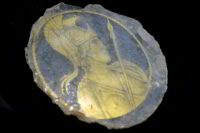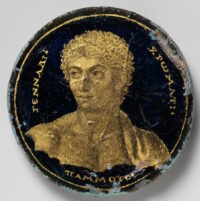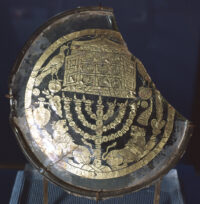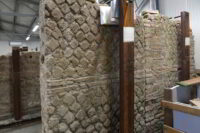 The first and only known personification of Rome in ancient gold glass has been discovered during construction of Rome’s Metro C subway line. It was found at the Porta Metronia station where military barracks were unearthed in 2016. The gold glass artifact will go on display in a new subway station museum that will include an in situ exhibition of the barracks.
The first and only known personification of Rome in ancient gold glass has been discovered during construction of Rome’s Metro C subway line. It was found at the Porta Metronia station where military barracks were unearthed in 2016. The gold glass artifact will go on display in a new subway station museum that will include an in situ exhibition of the barracks.
The iconographic theme is already well-known, but it is the first and only representation found so far on golden glass.
“Golden glass is already a very rare finding, but this has no comparison” according to preliminary findings, Simona Morretta, archaeologist of the special superintendency of Rome, explained to ANSA. “No golden glass with the personification of the city of Rome had ever been found before”.
Gold glass was a glass-making technique in which a thin layer of decorated gold leaf, often a portrait, was sandwiched between two layers of transparent glass. The leaf was glued to one glass discs first, then the design created by scratching away tiny areas of gold like an etching. A second glass disc was then superimposed on top of the etched gold surface and fused to create the roundel of a vessel or a medallion.
 The process of embedding a thin film of gold inside glass originated in Hellenistic Greece (4th-3rd century B.C.), but glassmakers of the Late Roman Empire (3rd-4th century A.D.) refined it to create veritable portrait miniatures in medallions and the roundels of ritual vessels. The portraits could be strikingly realistic, and ones produced in Alexandria are sometimes eerily close cognates to the Fayuum mummy portraits in style.
The process of embedding a thin film of gold inside glass originated in Hellenistic Greece (4th-3rd century B.C.), but glassmakers of the Late Roman Empire (3rd-4th century A.D.) refined it to create veritable portrait miniatures in medallions and the roundels of ritual vessels. The portraits could be strikingly realistic, and ones produced in Alexandria are sometimes eerily close cognates to the Fayuum mummy portraits in style.
Religious imagery was a popular motif for gold glass artifacts. Examples with Greco-Roman, Christian and Jewish iconography have been found, many of them deliberately broken and the decorated base affixed to the wall next to burial niches in the catacombs of Rome. About 500 pieces  of Roman gold glass have been found in catacombs, almost all of them Christian. Pagan, Christian and Jewish gold glass vessels contain traditional phrases like “vivas” (“you live”) that were common Roman expressions of good luck and libation. This suggests they were produced by the same workshops and the imagery altered to appeal to people of different faiths.
of Roman gold glass have been found in catacombs, almost all of them Christian. Pagan, Christian and Jewish gold glass vessels contain traditional phrases like “vivas” (“you live”) that were common Roman expressions of good luck and libation. This suggests they were produced by the same workshops and the imagery altered to appeal to people of different faiths.
There is no inscription on the recently-discovered personification of the Eternal City. She wears an Amazonian-style dress, a helmet with a plumed crest and a diadem on the forehead. She carries a spear across her chest. The details are very finely crafted, from the curls of her hair to the scrollwork on the helmet.
 As with the roundels found in the catacombs, the gold Roma was cut out of a vessel, likely when it was damaged, and kept as a precious object for display. It was not mounted on a wall of the barracks, however. The military abandoned that site in the mid-3rd century and the structure left behind was cut down and buried. The tops of the walls were demolished and the site filled with debris. The gold glass was found in this fill layer which dates it to the early 4th century.
As with the roundels found in the catacombs, the gold Roma was cut out of a vessel, likely when it was damaged, and kept as a precious object for display. It was not mounted on a wall of the barracks, however. The military abandoned that site in the mid-3rd century and the structure left behind was cut down and buried. The tops of the walls were demolished and the site filled with debris. The gold glass was found in this fill layer which dates it to the early 4th century.
The Porta Metronia station is scheduled to open in late 2024. It’s a great location for a museum, a short, enjoyable walk from the Via Appia along a grassy park following a well-preserved section of the Aurelian Wall. I am looking forward to the prospect of walking that stretch again someday and enjoying a unique museum instead of just being cut off by construction chaos.